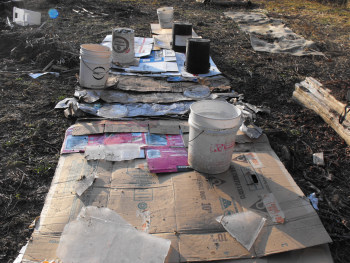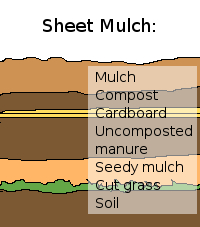
How to Make a Sheet Mulch
 Sheet mulching, lasagna
gardening, and no-till farming are all related by the effort to
grow crops without disturbing the soil. They're trying to prevent
the damage done by tilling, a common practice which mixes soil
profiles, kills important soil organisms, and often causes
erosion. Instead, thick layers of organic matter are applied
right on top of untouched soil, mimicking the leaf litter layer in a
forest which prevents weed seeds from sprouting, holds in water, and
provides a home for many soil organisms.
Sheet mulching, lasagna
gardening, and no-till farming are all related by the effort to
grow crops without disturbing the soil. They're trying to prevent
the damage done by tilling, a common practice which mixes soil
profiles, kills important soil organisms, and often causes
erosion. Instead, thick layers of organic matter are applied
right on top of untouched soil, mimicking the leaf litter layer in a
forest which prevents weed seeds from sprouting, holds in water, and
provides a home for many soil organisms.
I would love to lasagna garden, but I just don't have the excess
organic matter it requires. I do intend to include some sheet
mulching in my new forest garden, though, especially where the Japanese
honeysuckle is so bad. Monday afternoon, I tore up some old
cardboard boxes I had in the barn to start the big golf cart path which
will run through the north end of the forest garden. For those of
you without access to my new favorite book, here are the basic steps of
a sheet mulch:
 Mow the existing vegetation
close to the ground. (Chicken tractors do a great job!)
Mow the existing vegetation
close to the ground. (Chicken tractors do a great job!)
- Wet the ground thoroughly, or just start after a heavy rain.
- If possible, lay
down seedy organic matter (mulch and/or manure.) Not mandatory,
especially in a path --- I'm skipping this phase for my golf cart
path.
- Lay cardboard or newspaper thoroughly over the area, overlapping 4-6 horizontal inches at all seams. Newspaper should be at least six sheets thick. Don't worry, this layer will decompose in a year or less.
- If you're going to
be planting on top of the sheet mulch, add compost --- this turns it
into a lasagna garden. Not necessary for paths or for areas where
you won't be planting until next year.
- Top it off with at
least an inch of seed-free mulch of any kind. I'll be using old
wood chips in my paths --- they might leach nitrogen if used on beds,
though.
I've only done steps one
through 4, and only over a small area, but I'll keep poking at it until
I run out of cardboard and mulch. This is a good task for cold
winter days when you really want to garden but the ground is frozen!
Want more in-depth information? Browse through our books.
Or explore more posts by date or by subject.
About us: Anna Hess and Mark Hamilton spent over a decade living self-sufficiently in the mountains of Virginia before moving north to start over from scratch in the foothills of Ohio. They've experimented with permaculture, no-till gardening, trailersteading, home-based microbusinesses and much more, writing about their adventures in both blogs and books.
Want to be notified when new comments are posted on this page? Click on the RSS button after you add a comment to subscribe to the comment feed, or simply check the box beside "email replies to me" while writing your comment.

Lately stumbled upon an interesting, even controversial page with a wider viewpoint on sheet mulching
www.mdvaden.com/lasagna_gardening.shtml
The page in entirety leaves the door open for two responsible approaches, as long as gardeners consider all the options, benefits and consequences. What criteria do you think would be the most practical for a checklist? For example, supposing the writer is correct, when does it become the better option to sheet mulch? Thanks, Phil. Will check back in a few weeks.
Very interesting article! Thanks for pointing that out!
I'm all for overthinking the garden --- it's what I do best. I can totally see your point that the newspaper and cardboard would be better recycled (although in practice I've noticed that lots of places trash their "recycling" rather than paying to have it recycled. In that case, sheet mulching would definitely be a better option.)
I can totally see your point that the newspaper and cardboard would be better recycled (although in practice I've noticed that lots of places trash their "recycling" rather than paying to have it recycled. In that case, sheet mulching would definitely be a better option.)
I always think that it's better to use resources at hand than transport them from a distance, no matter what they are. So, cardboard and paper that shows up on my doorstep goes into the garden, but I don't actively hunt it down. Instead, I'm leaning toward more mulches from grass clippings and leaves, all from on site.
Thanks for the thought-provoking comment!